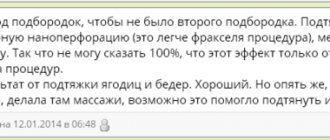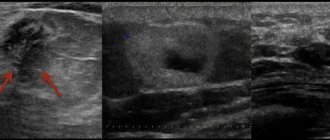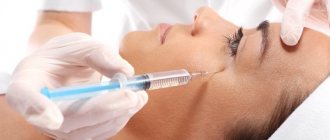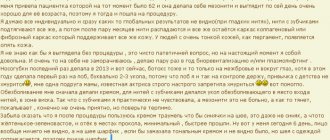Thread lifting is a highly effective modern method of rejuvenation. It is very popular due to the ease of implementation and the effectiveness of the results obtained. Many patients decide to take the step of having their face tightened with threads. However, in order for the outcome of the procedure to be pleasing, it is necessary to follow the rules of behavior and skin care for several weeks after the facelift.
The rehabilitation process takes about one and a half months on average. There are cases of earlier recovery and later. There are three periods of rehabilitation:
- Primary edema. Lasts three days. This is the reaction of the skin and underlying tissues to intervention after a circular lift. It is characterized by pronounced swelling of the tissues.
- Resorption of edema. Occurs within two weeks.
- Recovery period. Lasts about a month. At this time, the skin takes on its new appearance, becomes tightened and elastic. Recovery after thread lift surgery occurs gradually. It is necessary to carefully follow all the recommendations of doctors so that the lifting effect is formed and properly manifested.
How to care for your face after a thread lift
1-3 days after thread lifting. Home mode. Minimum physical and mental activity; it is recommended not to use facial expressions when communicating. It is best to be in a reclining position, silently read a book, draw, watch TV shows or videos without emotions. It is optimal to listen to the radio or your favorite audio recordings. You cannot touch your face, wash your face, or apply creams and ointments (except those prescribed by the doctor). You need to sleep on your back. Consume food and water warm. Food should be neutral in taste and soft in order to use a minimum of muscles when chewing it. It is better to drink water through a straw or from a sippy cup. Alcohol and smoking are strictly prohibited! Be sure not to remove the compression mask for the first three days!
4-7 days. If necessary, you can leave the house. Avoid hot food and drinks, exposure to the open sun, solarium, sauna. Do not touch your face with your hands, do not use cosmetics. Communicate without facial activity: do not laugh or smile. In the summer, be sure to wear a wide-brimmed hat or Panama hat when leaving the house. Sports, light fitness, jogging, morning exercises, any physical activity (including intimate) is prohibited. If the swelling has decreased significantly, you can wash your face using warm boiled water and a clean cotton pad using gentle, gentle blotting movements. At home, wear a compression mask and sleep in it.
8-14 days. You can eat your usual food at any temperature. Walking during periods of low solar activity returns to the daily routine. Sauna, beach and solarium, and other hot temperatures are not yet for you. Massage, cosmetics, intense physical activity, including facial expressions, are also prohibited. But you can wash your face more confidently with warm water using a cotton pad. In this case, a face that has recently been lifted should not be rubbed or squeezed. You can sleep not only on your back, but also on your side (but you shouldn’t sleep “with your head buried in the pillow” yet).
15-30 day . Return to normal daily routine. Expanding your social circle. Sleep in your favorite position, morning and evening washes. After washing, gently dry the skin by applying a soft, clean towel (preferably disposable) to it with blotting movements. It is allowed to go to work that does not require physical activity. There is no need to visit the sauna and solarium, play sports and fitness, or go on vacation to a hot country.
A month later, after the doctor’s approval, you can gradually return to your normal lifestyle.
Contraindications to the procedure
Kogi threads are biocompatible and do not cause irritation, but in order to exclude individual intolerance, it is important to conduct a full initial examination. During the consultation, the specialist explains in detail what the threads are, how they are installed in the skin, what sensations the patient may have when installing the threads and after the procedure. Also, the cosmetologist is obliged to tell in what cases mesothreads are used for the face and what the consequences of their installation may be if the recommendations are not followed. Also at the initial consultation, possible contraindications are assessed:
- The presence of tumors, both malignant and benign
- Severe hypertension
- Autoimmune disorders
- Chronic pathologies of the heart and blood vessels in the acute stage
- Connective tissue pathologies, tendency to form keloid scars
In addition, there are recommendations that should also be followed. Women are not advised to carry out the procedure during pregnancy, as well as before the end of lactation. Be sure to tell your doctor about all allergic reactions, especially to medications. Only after this will the doctor be able to assess the feasibility of using mesothreads and calculate their number.
What not to do after installing threads
After thread lifting, there are several strict restrictions:
- High temperatures: both external - when visiting a sauna or steam bath, solarium, beach recreation areas, and local: taking a hot shower or bath, eating, drinking. This increases swelling and prevents rapid skin recovery.
- Contact of facial skin with any objects and surfaces , including your own fingers and cosmetics. There is a high risk of skin contamination and infection.
- Washing with water irritates the skin, making swelling worse. With sudden movements and rough wiping, there is a high risk of tissue displacement and asymmetry.
- Active facial expressions, massage . You cannot sit with your chin or cheek on your hand. Any mechanical impact easily provokes displacement of the threads, causing asymmetry, which is extremely undesirable after a facelift.
- Sleeping on your stomach (and in the first days on your side) leads to increased swelling and can contribute to skin infection and displacement of the facelift threads.
- Singing lessons and visits to the dentist will have to be postponed: prolonged tension of the facial muscles can cause the threads to shift.
- Swimming, sports and fitness , intense physical activity are prohibited for a long period - they negatively affect the skin restoration process and provoke asymmetry of facial muscles.
Age restrictions and contraindications
Thread facelift is usually prescribed to patients after 35-40 years of age. If necessary, this procedure can be performed at an earlier age.
Contraindications for its implementation are:
- pregnancy;
- lactation;
- blood diseases;
- inflammatory processes at the sites of insertion of threads;
- oncology;
- acute period of infectious diseases;
- tendency to keloid scars;
- autoimmune disorders;
- diabetes.
Side effects after face lift with threads
Not everyone experiences side effects after facelift surgery and go away fairly quickly. But it’s better to be aware of possible troubles and think through an action plan in advance.
Violation of facial expressions is the result of anesthesia during the insertion of threads. As a rule, it goes away after two to three hours. Some note disturbances in facial expressions lasting 3-4 days until the swelling caused by the facelift completely subsides, because the swelling itself also makes it difficult to actively move the facial muscles.
Get an online consultation
right now.
Get
Minor effects of unevenness on the skin at the puncture site and along the placement of the threads made. The body tissues get used to the new location after facelift threads are introduced into them. By the end of the second week, they usually smooth out without any intervention.
Hypercorrection - a feeling of “tightness” of the face can also be a consequence of tissue swelling in the first days after lifting. With the disappearance of edema, the “unnatural” appearance of the face disappears.
Bruises and small bruises are the result of damage to small blood vessels after a circular facelift, which inevitably happens even with very careful punctures of the skin. Within a few days they resolve on their own, and then disappear without a trace.
Photos "before" and "after"
Preoperative markings for thread lifting
Photos “before” and 6 days “after”. Pronounced lifting of the chin, deepening of the neck-chin angle.
Hollywood neck lift using the author's method Andrey Iskorneva. Perfect chin without sagging.
Upper and lower transconjunctival blepharoplasty. Neck liposuction. Thread neck lift. Removing Bish's lumps. Botulinum therapy. Lip contouring with Equio. Surgeon: Iskornev Andrey.
Complications after lifting
By the end of the second week, no skin lesions should remain. All side effects should also disappear. A little swelling is allowed, but most often the result of successful lifting is already clearly visible. A face strengthened with threads looks much younger: you can carefully take a photo and compare “before and after.” Rarely do situations arise that require doctor intervention:
- Bruising and severe swelling that persist for more than ten days. Primary rehabilitation after threads is over by this time, there should be no bruising or swelling. If they still exist, you need to visit the doctor and find out the reason.
- Allergy to material. Face threads are made from modern hypoallergenic materials. But a hypersensitivity reaction may also occur to them, albeit extremely rarely with thread lifting. Unfortunately, in this case you have to part with the threads.
- Infection. The skin becomes red and hot to the touch. Severe pain appears and the temperature rises. A course of antibiotics often helps, and threads have to be removed less often and complex therapy performed.
- A persistent violation of facial expressions indicates injury or even compression of nerve fibers. The doctor conducts an examination and removes the face lift thread that is in contact with the nerve and impeding muscle movement.
- Lumps on the face and indentations on the skin. They are usually located at the points of needle insertion and removal. Most often, the threads for a facelift are displaced due to non-compliance with the rules of behavior in the early rehabilitation period (the first two weeks). It is necessary to consult a doctor, who in most cases can cope with the bumps using a non-surgical method.
Removing threads
There are many scary stories and myths associated with the removal of threads (primarily notches and cones): the threads grow in, when they are removed, the tissues are torn, and pits and scars remain on the face. “In fact,” says Igor Gulyaev, “if necessary, the threads are removed very easily. This is done with a regular tiny hook or an injection needle with a curved tip, using only local anesthesia.
“The thread is most easily removed when inflammation develops,” says our expert. – Firstly, in this case it is clearly visible on an ultrasound. Secondly, the inflamed tissues are much more loose, and the thread can be easily pulled out. But with other types of complications, no tissue rupture occurs. The thread is cut in several places and is always pulled out along the notches, without damaging the tissue at all. If the thread is linear, no more than three punctures are required to remove it, if it is in the form of a loop, a few more.
It is only the removal of threads in the long term that causes some difficulty for doctors, since the thread may already be covered with a dense capsule and is fixed in the tissues much more reliably. But fortunately, this happens extremely rarely.
“Braces using threads are good primarily because they are reversible,” emphasizes Igor Gulyaev. – And this applies not only to the development of complications. Like any technique, thread lifting is subject to a certain fashion. Not so long ago, women liked high Asian cheekbones, which were created using a loop thread. Today this trend has practically disappeared. And in general, ideas about beauty are very subjective, and they may not always coincide between the doctor and the patient.
Even if the procedure is performed correctly and someone simply does not like the result, doctors have about two months to remove the threads and return the patient to his original appearance without any negative consequences.
Thread lifting: popular problems and brief comments
My skin hurts after having a facelift.
This is normal for the first 3-4 days. The intensity of pain depends on the individual pain threshold. If the pain seems too severe, consult your doctor. You may need analgesics.
What should I do if two weeks have passed and the swelling persists?
If the swelling doesn't get worse, there's usually nothing to worry about. This may be due to the individual characteristics of the body. If the swelling intensifies, you need to consult a doctor.
Too many bruises on my face.
Most likely, you have reduced blood clotting, or the intervention was performed shortly before the start of menstruation. If the bruises associated with thread lifting gradually disappear, there is nothing terrible; if they increase, you need to consult a doctor.
Why can't I use cosmetics?
The risk of skin infection increases. Applying and removing cosmetics is accompanied by stretching of the facial skin, which is extremely undesirable after lifting.
When can you leave the house?
It is recommended to leave the house no earlier than the fourth day, when all unwanted effects on the face become invisible. There is also a risk of infection (the operated person is very vulnerable at first). If you don't mind your appearance, don't limit yourself. But you need to wear a compression mask for at least 3 days constantly.
Why can't you touch your face with your hands?
Cost of thread lifting with Kogi threads
The price of the procedure is determined individually depending on the severity of the problem and the expected effect. The cost of one Kogi thread is 2200 rubles. Accordingly, if five threads are required to achieve the result, the price will be 11,000 rubles. The cosmetologist will be able to tell the exact price of the service only after consultation and examination of the patient.
Prices for threadplasty
| NEEDLE 2G (2 strands) mental area | 36,000 rub. | ||||
| NEEDLE 2G (2 threads) middle zone | 36,000 rub. | ||||
| SPRING (4 threads) wrinkles of sadness | RUB 21,500 | ||||
| THREAD 2G (2 threads) eyebrows | 35,000 rub. | ||||
| THREAD 2G (2 threads) mental area | 35,000 rub. | ||||
| THREAD 2G (2 threads) middle face area | 35,000 rub. | ||||
| VISAGE 10 threads 2 zones | 38,000 rub. | ||||
| Mesothread thread lifting | 1,200 rub. | ||||
| KOGI threads (1 piece) | 2,200 rub. | ||||
| KOGI threads (5 pcs) | 11,000 rub. | ||||
Types of threads used for lifting
The approach to each patient in our aesthetic medicine center is strictly individual, therefore, among the surgeon’s instruments there are several types of threads, which are used after a clear analysis of the situation and the condition of the client’s skin:
1. Non-absorbable surgical sutures.
Threads consisting of polypropylene with lactic acid nodules located on them (Silhouette Lift) are inserted into the skin. This material is not broken down in the body, and lactic acid activates the production of natural collagen fibers, which then form an additional frame around each thread. Subsequently, the inserted threads can be tightened again to restore the rejuvenation effect. The very first procedure guarantees results lasting up to six years. At the same time, such threads become a preventive measure against tissue prolapse. They work for both those who have just turned 35 and those who are fifty.
2. Polylactic acid with notches.
In the human body, such threads, which help eliminate sagging skin and prevent age-related changes, are completely broken down.
The structure of the threads itself (Aptos, Dermafil)
is very smooth, and small notches are provided for attaching the connective tissue. This material is compatible with the human body, so the threads can be implanted into especially deep layers of the skin. For nine months, the lifting result is very noticeable, then the thread dissolves, but the rejuvenating effect does not disappear. Lactic acid has a beneficial effect on cells that produce collagen, activating them and causing them to intensively regenerate. It turns out that these types of threads prevent the development of age-related changes.
3. Mesothreads
. The basis of this material is liquid gel. It does not become a bioframework by itself, but causes natural processes to activate, thanks to which new connective tissue appears. As a result, wrinkles are smoothed out. Liquid threads allow you to restore the beauty of youth to the skin of your neck.











